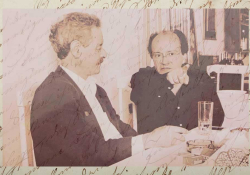“Gangnam Style”: Crossing Over in the New World

Anthropologists and linguists no doubt are having a field day trying to chronicle and dissect how, in the early autumn of 2012, “Gangnam Style” became an American idiomatic expression. It stands for something along the lines of a brash, flamboyant way of doing things, clownishness, or an act of in-your-face spoofing that is both original and entertaining.
A Wikipedia page showcases “Gangnam Style” as the most-watched YouTube video of the year. The video has garnered more than one billion hits since July and counting, surpassing the previous number-one hit on YouTube—“Baby,” by Justin Bieber—and has spun off countless other videos—notably North Korea’s own version to spoof a South Korean presidential candidate and “Mitt Romney Style.”
And the genius behind the dance that mimics riding an invisible horse? Jae-Sang Park, erstwhile PSY (short for psycho), a rapper whose career galloped into global superstardom with the distinction of topping iTunes charts in the US, the UK, Australia, and twenty-eight other countries. PSY’s video is also the most “liked” on YouTube, as well as the most-watched video in Korean entertainment history.
But something beyond Korean history has clearly occurred with the global sanctification of PSY. It’s the history of crossover itself, the phenomenon that has traditionally been treacherous and cruel with so many talented entertainers from the Far East, or elsewhere at the margins of the commonwealth, falling off the tightrope on the way to global stardom.
To cross over, as far as the worlds of art and entertainment are concerned, is to go from the margin to the center, and to go from one culture to another, trying to succeed in the latter. But as a rule, it demands the betrayal of the original, and it requires reinvention: something of a bane to poetry, and nearly impossible for those who are entrenched in their own languages, cultural sensibilities, and references.
Take the cases of Hong Kong actors Chow Yun Fat and Jackie Chan, and the South Korean singer Bi Rain as primary examples. Bi Rain, with his extraordinary dancing skills and teenage heartthrob status, is known all over Asia as its own Michael Jackson. But Rain met with drought in North America, where he starred in two movies that flopped, and his bid for global stardom was quickly denied. Chow Yun Fat, voted by the Los Angeles Times “the coolest actor” in the world in the mid-1990s, also failed in Hollywood, in part because that very Hong Kong-coolness turned lukewarm in Hollywood movies, and the hard-boiled image that made him famous in the East came off as stilted in the West. Having bombed at the box office with his action movies, Chow ended up playing a stereotypical, hideous character in Pirates of the Caribbean: At World’s End. His role was deemed so offensive that it was cut in the version shown in China.
Jackie Chan, the most successful of them all, is worthy of note for his repeated attempts over three decades to be an action star in Hollywood. And when he finally made it big, he was, alas, already steeped in middle age.
Then came PSY, whose crossover moment seems to suggest a major shift in the history of the entertainment world itself. For one thing, it turns the old rules upside down: that crossing over requires giving up the original way of doing things, that the odds are stacked against those who try, and that it takes years of toil and perseverance, even for the super sexy, cool, and talented. Or, at the very least, you have to leave your home country to do so.
Well, not anymore, not if you do it “Gangnam Style.” The first thing for cultural critics to take note of is the speed with which a cultural event can transmit these global days: PSY burst like a supernova from regional to world stage within a few weeks’ time. And he didn’t even need to leave Seoul. The second thing to take note of is equally important, if not more so: His video, performed in Korean, is downloaded largely by people who don’t understand one word of the language.
PSY, quite aware of this significance, told NPR: “If I have a chance I want my music lyric[s] to be Korean. . . . The world’s most famous and popular language is music. So if we have some sort of solution with these kinds of dance moves and this kind of music video so that I can use Korean if possible? It’s really huge history for my country.”
In other words, since he didn’t try to cross over but the phenomenon nevertheless crossed him, why not continue to do what he does best? It is this kind of thinking that may very well revolutionize the margin in its relationship to the center.
Let’s look at it another way: all major recording stars from England and North America do not worry about crossovers to the rest of the known world. There’s an undeniable centrality to the West; from the Beatles to Beyoncé to Lady Gaga, Western stars are to be idolized the world over, their songs memorized, even if their adoring fans don’t understand English. Broadcasting from the center, one has no need for translation. Whatever is good for the West is deemed good enough for the rest.
Such is the shape of the powers and unwritten rules taught subliminally long ago. Going from West to East, as well as elsewhere since the European conquest of the known world five hundred years ago, has always been a passage of relative ease. It does not demand transformation or self-reinvention from a Westerner. It is catered to.
The reverse, however, has always been a difficult path, an enormous undertaking. An American moving to Vietnam to work and live, for instance, need not speak Vietnamese to thrive; his language is coveted, his status assumed superior. A Vietnamese who hopes to make it big in the US needs to master the English language at the very least, or else he is condemned to smallness—ethnic enclave, menial labor, an outsider, a minority and irrelevant.
The significance of the “Gangnam Style” video is extraordinary in that it refutes that assumption: it assumes a centrality all on its own. It sets its own terms, has its own rhythm, and dwells in its own particularities.
Yet its rise to universality is no fluke. Its success occurs when the world is shifting in radical ways, at a time when individuals empowered by information technology can change world history. Witness the video that vilified the Prophet Muhammad by a Coptic Christian Egyptian living in California, which caused massive protests against the US in September 2012 and undermined soft US foreign policy in the Middle East; or the Tunisian fruit seller whose self-immolation a year earlier, captured on cell phones and broadcast online, ignited the Arab Spring, leading to regime changes in several countries.
The “Gangnam Style” video also arrived at a moment when the East is integrating with the West at full speed, reiterating the idea that globalization is no longer a one-way love affair. It arrived at a time when yoga is replacing aerobics, acupuncture and herbal treatments are alternative choices for treating chronic diseases, the world’s children are enthralled by Japanese anime and manga, and kung fu is becoming the norm for action films. And in the area of culinary experience, it’s a sea change.
That a South Korean video gained global stardom is also no fluke. South Korea, after all, actively supports its artists and totes its pop culture abroad as part of its foreign policy. It takes as much pride in its cultural ascendancy as it does in its economic rise. It even built a Hallyu—Korean Wave—museum at the Incheon Airport to celebrate its global stars and their achievements. It is a country that insists on its own centrality and its own growing contribution to the cultural matrix that defines modern Asia.
Indeed, in Asia there is an old dream of resistance. It was first a dream of nineteenth-century Japan after the defeat of Russia in the Russo-Japanese War. It imagined the continent as one, a continuous land, its people interconnected. A century later, Prime Minister Lee Kuan Yew of Singapore resuscitated that idea during the rise of Asian economic powers in the post–Cold War era. While Lee spurred the phrase “Asian Values,” nearby Malaysia’s leader, Mahathir Mohamad, came up with a similar “Look East Policy.”
But those ideas had been more or less top-down, militaristic, and largely ideological—a regional, chauvinistic reaction to a colonial past and a need to assert a newfound prowess against Western influences. What is happening now, a couple of generations later, however, is much more organic, solidly on cultural ground, and hardly anti-West.
“Gangnam Style,” after all, is a rap song. And its rise occurs at a time when ours has become a world in which traditions exist side by side for the borrowing and taking, and, ultimately, the mixing. And it would seem that in a world where cultural integration and hybridization are the norm, all forms of art could become both at once intensely global and local.
Indeed, from religion to cuisine, from medicine to music, from dance to literature, from agricultural practices to filmmaking, all are available to the contemporary and confident alchemists to reshape and reimagine. The playing field is slowly being leveled.
So if America can make a movie called Kung Fu Panda and have it become a number one hit in China, then it follows that a Korean artist, too, can rise to the top of the charts in America, riding an invisible horse and rapping in his own language—Gangnam style, of course.
Editorial Note: For more on Korea’s popular culture, read WLT’s conversation with Kyung Uk Kim in the January 2013 issue of the magazine.










